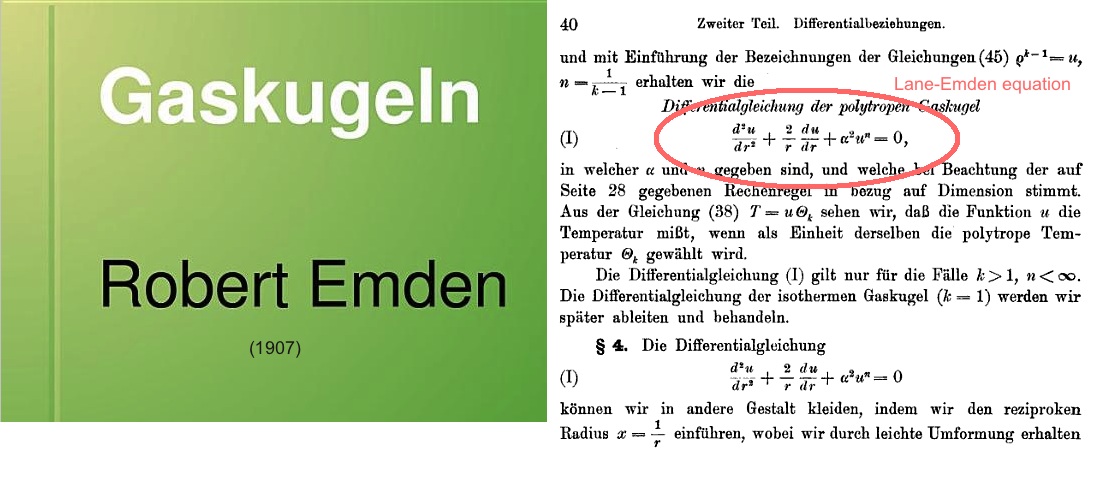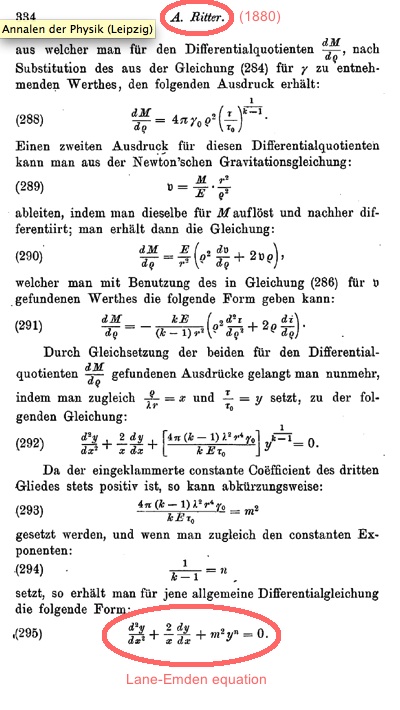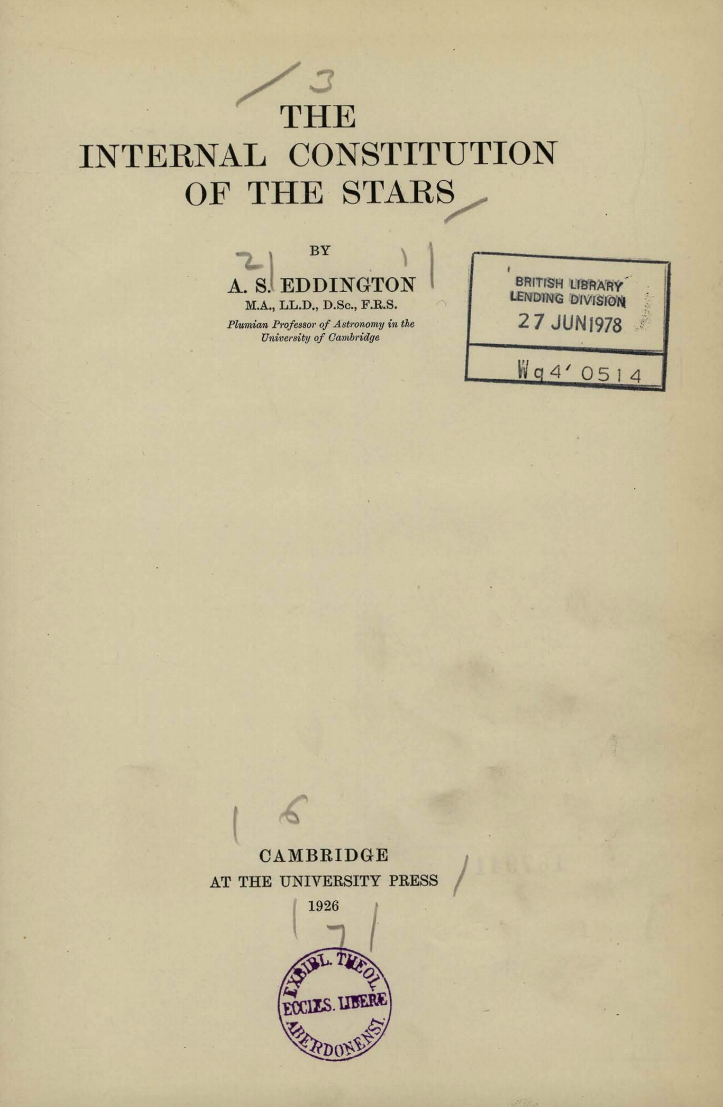Difference between revisions of "User:Tohline/Appendix/Equation templates"
| Line 738: | Line 738: | ||
* [<b><font color="red">BLRY07</font></b>] <span id="BLRY07">'''Bodenheimer, P., Laughlin, G. P., Różyczka, M. & Yorke, H. W.''' 2007,</span> Numerical Methods in Astrophysics <font size="-1">An Introduction</font> (New York: Taylor & Francis) | * [<b><font color="red">BLRY07</font></b>] <span id="BLRY07">'''Bodenheimer, P., Laughlin, G. P., Różyczka, M. & Yorke, H. W.''' 2007,</span> Numerical Methods in Astrophysics <font size="-1">An Introduction</font> (New York: Taylor & Francis) | ||
=<font size="+2" color="darkblue"> | =<font size="+2" color="darkblue">Other Equations with Assigned Templates</font>= | ||
<div align="center"> | <div align="center"> | ||
| Line 884: | Line 884: | ||
<td colspan=6> | <td colspan=6> | ||
Alternate form of the ideal gas equation of state. | Alternate form of the ideal gas equation of state. | ||
</td> | |||
</tr> | |||
<tr> | |||
<td> | |||
[[User:Tohline/Math/EQ_TRApproximation|EQ_TRApproximation]] | |||
</td> | |||
<td align="center"> | |||
{{User:Tohline/Math/EQ_TRApproximation}} | |||
</td> | |||
<td colspan=6> | |||
Gravitational Potential in the Thin Ring Approximation. | |||
</td> | </td> | ||
</tr> | </tr> | ||
Revision as of 22:37, 25 May 2018
 Key Equations
Key Equations

|
|---|
| | Tiled Menu | Tables of Content | Banner Video | Tohline Home Page | |
Each of the equations displayed in the Tables, below, encapsulates a physical concept that is fundamental to our understanding of — and, hence our discussion of — the structure, stability, and dynamics of self-gravitating fluids. The pervasiveness of these physical concepts throughout astrophysics is reflected in the fact that the same equations — perhaps written in slightly different forms — appear in numerous published books and research papers. When attempting to understand the physical concept that is associated with any one of these mathematical relations, it can be helpful to read how and in what context different authors have introduced the expression in their own work. These Tables offer guides to some parallel discussions that have appeared in published texts over the past 5+ decades in connection with selected sets of key physical relations.
EXAMPLE: Suppose you want to gain a better understanding of the origin of the ideal gas equation of state, the definition of the gas constant <math>~\Re</math>, or how to determine the value of the mean molecular weight <math>~\bar{\mu}</math> of a gas. According to the Table entitled Equations of State, you will find a discussion of the ideal gas equation of state: near Eq. (1) in §II.1 of Chandrasekhar (1967); near Eq. (80.8) in §IX.80 of Landau & Lifshitz (1975); near Eq. (5.91) in Vol. I, §5.6 of Padmanabhan (2000); etc. A "note" (linked to a comment further down on this page) appears along with a table entry if the relevant equation in the cited reference contains notations or symbol names that differ significantly from the equation as displayed here.
Principal Governing Equations
|
Principal Governing Equations |
||||||||||
|---|---|---|---|---|---|---|---|---|---|---|
|
To insert a given equation into any Wiki document, type ... |
Parallel References |
|||||||||
|
Template_Name |
Resulting Equation |
C67 |
LL75 |
H87 |
ST83 |
KW94 |
P00 |
BLRY07 |
||
|
Continuity Equation:
|
|
§I.1 |
§5.4 |
§6.1 |
§2.5 |
I: §8.5 |
§1.4 |
|||
|
Euler Equation:
|
|
§I.2 |
§5.4 |
§6.1 |
§2.5 |
I: §8.5 |
§1.4 |
|||
|
1st Law of Thermodynamics:
|
|
§I.2 |
§4.2 |
§6.1 |
§4.1 |
I: §8.5 |
|
|||
|
Poisson Equation:
|
|
§I.3 |
|
§6.1 |
§1.3 |
I: §10.2 |
Chap. 7 |
|||
Equations of State
|
Equations of State |
||||||||||||||
|---|---|---|---|---|---|---|---|---|---|---|---|---|---|---|
|
To insert a given equation into any Wiki document, type ... |
Parallel References |
|||||||||||||
|
Template_Name |
Resulting Equation |
C67 |
LL75 |
H87 |
ST83 |
KW94 |
P00 |
BLRY07 |
||||||
|
Ideal Gas Equation of State:
|
§II.1 |
§IX.80 |
§1.1 |
§2.3 |
§13.0 |
I: §5.6 |
§5.4 |
|||||||
|
Degenerate Electron Pressure:
——— NOTE: ——— <math> F(\chi) = 2\chi^4 - 2\chi^2 + \cdots ~~~~~~~(\mathrm{for}~~ \chi\gg 1) </math> |
§X.1 |
|
§11.2 |
§2.3 |
§15.0 |
I: §5.9.2 |
§5.6.1 |
|||||||
|
Radiation Pressure:
|
|
|
§12.1 |
|
|
|
§5.6.1 |
|||||||
|
Normalized Total Pressure:
|
|
|
|
|
|
|
|
|||||||
Traditional Equations of (Spherical) Stellar Structure
|
Traditional Equations of (Spherical) Stellar Structure |
||||||||||
|---|---|---|---|---|---|---|---|---|---|---|
|
To insert a given equation into any Wiki document, type ... |
Parallel References |
|||||||||
|
Template_Name |
Resulting Equation |
C67 |
LL75 |
H87 |
ST83 |
KW94 |
P00 |
BLRY07 |
||
|
Mass Conservation:
|
§IV.2 |
|
|
§3.2 |
§9.1 |
II: §2.2 |
§5.1 |
|||
|
Hydrostatic Balance:
|
§IV.2 |
|
|
§3.2 |
§9.1 |
II: §2.2 |
§5.1 |
|||
|
Polytropic Lane-Emden Equation:
|
§IV.2 |
|
|
§3.3 |
§19.2 |
I: §10.3 |
|
|||
|
Isothermal Lane-Emden Equation:
|
§IV.22 |
|
|
|
§19.8 |
I: §10.3.3 |
|
|||
Stability: Radial Pulsation
|
Stability: Radial Pulsation |
||||||||||
|---|---|---|---|---|---|---|---|---|---|---|
|
To insert a given equation into any Wiki document, type ... |
Parallel References |
|||||||||
|
Template_Name |
Resulting Equation |
C67 |
ST83 |
KW94 |
HK99 |
P00 |
||||
|
LAWE: Linear Adiabatic Wave (or Radial Pulsation) Equation
|
|
§6.5 |
§38.1 |
§10.1.1 |
II: §3.7.1 |
|||||
|
Polytropic LAWE:
|
|
|
|
|
|
|||||
|
Isothermal LAWE:
|
|
|
|
|
|
|||||
Key Parallel References (printed texts spanning 5+ decades)
- [C67] Chandrasekhar, S. 1967 (originally, 1939), An Introduction to the Study of Stellar Structure (New York: Dover)
- EQ_EOSideal0A — In C67, the ideal gas equation of state is initially written in terms of the specific volume <math>~V</math>, instead of the mass density <math>~\rho</math>; also, it is initially assumed that <math>~\bar{\mu}</math> = 1. Both <math>~\rho</math> and <math>~\bar{\mu}</math> are introduced in §III.1, Eq.(5).
- EQ_SSLaneEmden01 — At the end of his Chapter IV, C67 writes an extensive history of the earliest work on stellar structure pointing especially the origins of the so-called Lane-Emden equation. He points out, for example, that Ritter (1880) actually published this governing differential equation prior to Emden.
- [LL75] Laundau, L. D. & Lifshitz, E. M. 1975 (originally, 1959), Fluid Mechanics (New York: Pergamon Press)
- EQ_Continuity01 — LL75 present the Eulerian, rather than the Lagrangian form of the Continuity equation.
- EQ_Euler01 — In the Euler equation, LL75 do not initially include a source term to account for a gradient in the Newtonian gravitational potential, <math>~\Phi</math>; a term representing acceleration due to gravity, <math>\vec{g} = -\nabla\Phi</math>, is introduced in Eq.(2.4), but in LL75 this is intended primarily to describe gravity at the surface of the Earth.
- EQ_FirstLaw01 — LL75's Eq.(2.5) must be combined with their discussion of what they refer to as the familiar thermodynamic relation (between LL75 Eqs. 2.8 and 2.9) in order to appreciate the similarity with our expression.
- EQ_Poisson01 — In LL75, the symbol <math>\Delta</math>, rather than <math>\nabla^2</math>, is used to represent the Laplacian spatial operator.
- EQ_EOSideal0A — In LL75, the ideal gas equation of state is written in terms of the specific volume <math>~V</math>, as well as in terms of the mass density <math>~\rho</math>.
- [ST83] Shapiro, S. L. & Teukolsky, S. A. 1983, Black Holes, White Dwarfs, and Neutron Stars: The Physics of Compact Objects (New York: John Wiley & Sons); republished in 2004 by WILEY-VCH Verlag GmbH & Co. KGaA
- EQ_Continuity01 — ST83 present the Eulerian, rather than the Lagrangian form of the Continuity equation.
- [H87] Huang, K. 1987 (originally 1963), Statistical Mechanics (New York: John Wiley & Sons)
- EQ_Continuity01 — H87 presents the Eulerian, rather than the Lagrangian form of the Continuity equation, and the variable <math>\vec{u}</math> is used instead of <math>~\vec{v}</math> to represent the velocity.
- EQ_Euler01 — H87 presents the Eulerian, rather than the Lagrangian form of the Euler equation, and the variable <math>\vec{u}</math> is used instead of <math>~\vec{v}</math> to represent the velocity. Furthermore, to match the source term in our version of the Euler equation, we must set H87's applied acceleration, <math>\vec{F}/m = -\nabla</math><math>~\Phi</math>.
- EQ_FirstLaw01 — H87 begins a discussion of the 1st Law of Thermodynamics in the first section of the first chapter, but it does not appear in the form we present (relevant for a "dilute gas") until Eq.(4.31).
- [BT87] Binney, J. & Tremaine, S. 1987, Galactic Dynamics (Princeton, NJ: Princeton University Press)
- [KW94] Kippenhahn, R. & Weigert, A. 1994, Stellar Structure and Evolution (New York: Springer-Verlag)
- EQ_Continuity01 — KW94 present the Eulerian, rather than the Lagrangian form of the Continuity equation.
- EQ_FirstLaw01 — In KW94, the symbol <math>u</math> instead of <math>~\epsilon</math> is used to represent the specific internal energy.
- EQ_EOSideal0A — In KW94, the ideal gas equation of state is actually first introduced in §2.2, Eq.(27), but it is seriously discussed in Chapter 13. KW94 provide a particularly nice explanation of how to calculate the model parameter, <math>~\bar{\mu}</math>.
- EQ_SShydrostaticBalance01 — In KW94, the hydrostatic balance equation is expressed in terms of <math>dP/dM_r</math> instead of <math>dP/dr</math>; and the second term on the right-hand-side allows for a net radial acceleration.
- [HK99] Hansen, C. J. & Kawaler, S. D. 1999, Stellar Interiors: Physical Principles, Structure, and Evolution (New York: Springer)
- [P00] Padmanabhan, T. 2000, Theoretical Astrophysics. Volume I: Astrophysical Processes (Cambridge: Cambridge University Press); and Padmanabhan, T. 2001, Theoretical Astrophysics. Volume II: Stars and Stellar Systems (Cambridge: Cambridge University Press)
- EQ_Poisson01 — See also Vol.I: §10.4, Eq.(10.58).
- [BLRY07] Bodenheimer, P., Laughlin, G. P., Różyczka, M. & Yorke, H. W. 2007, Numerical Methods in Astrophysics An Introduction (New York: Taylor & Francis)
Other Equations with Assigned Templates
|
To insert a given equation into any Wiki document, type ... |
|||||||||||||||
|
Template_Name |
Resulting Equation |
Description |
|||||||||||||
|---|---|---|---|---|---|---|---|---|---|---|---|---|---|---|---|
|
<math>~\frac{\partial\rho}{\partial t} + \nabla \cdot (\rho \vec{v}) = 0</math> |
Eulerian (and Conservative) form of the continuity equation. |
||||||||||||||
|
<math>~\frac{\partial\vec{v}}{\partial t} + (\vec{v}\cdot \nabla) \vec{v}= - \frac{1}{\rho} \nabla P - \nabla \Phi</math> |
Eulerian form of the Euler equation. |
||||||||||||||
|
<math>~\frac{\partial(\rho\vec{v})}{\partial t} + \nabla\cdot [(\rho\vec{v})\vec{v}]= - \nabla P - \rho \nabla \Phi</math> |
Conservative form of the Euler equation. |
||||||||||||||
|
<math>~\frac{\partial\vec{v}}{\partial t} + \vec\zeta \times \vec{v}= - \frac{1}{\rho} \nabla P - \nabla \biggl[\Phi + \frac{1}{2}v^2 \biggr] </math> |
Euler equation in terms of vorticity. |
||||||||||||||
|
<math>~\frac{d\epsilon}{dt} + P \frac{d}{dt} \biggl(\frac{1}{\rho}\biggr) = 0</math> |
Adiabatic form of the 1st Law of Thermodynamics. |
||||||||||||||
|
<math>~P = K_\mathrm{n} \rho^{1+1/n}</math> |
Polytropic equation of state. |
||||||||||||||
|
<math>~H = (n+1)K_\mathrm{n} \rho^{1/n}</math> |
Enthalpy in a polytrope. |
||||||||||||||
|
<math>~\rho = \biggl[ \frac{H}{(n+1)K_\mathrm{n}} \biggr]^n </math> |
Density in terms of enthalpy for polytrope. |
||||||||||||||
|
<math>~P = n_g k T</math> |
Alternate form of the ideal gas equation of state. |
||||||||||||||
|
<math>~P = (\gamma_\mathrm{g} - 1)\epsilon \rho </math> |
Alternate form of the ideal gas equation of state. |
||||||||||||||
|
Gravitational Potential in the Thin Ring Approximation. |
||||||||||||||

|
|---|
|
© 2014 - 2021 by Joel E. Tohline |


